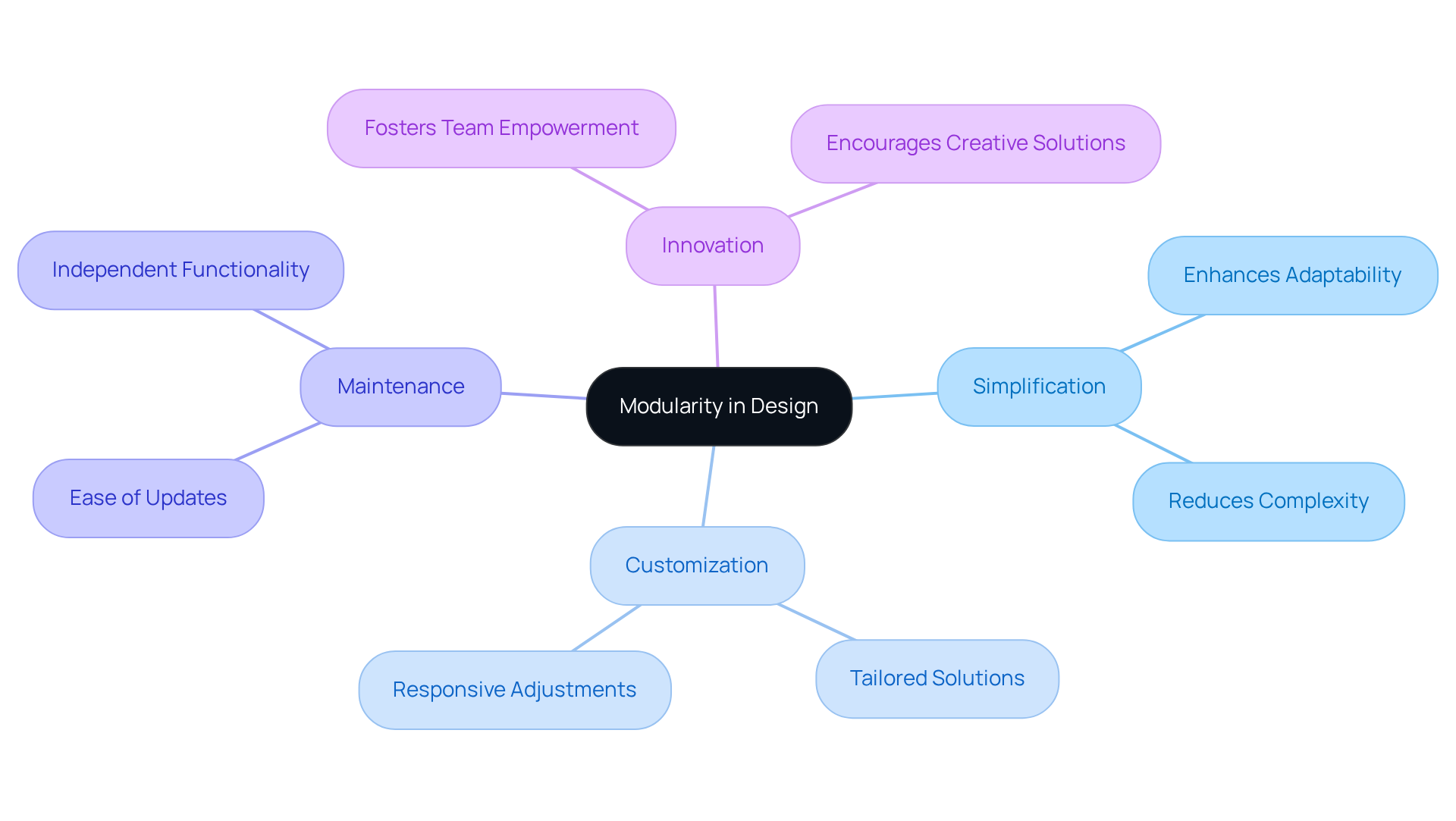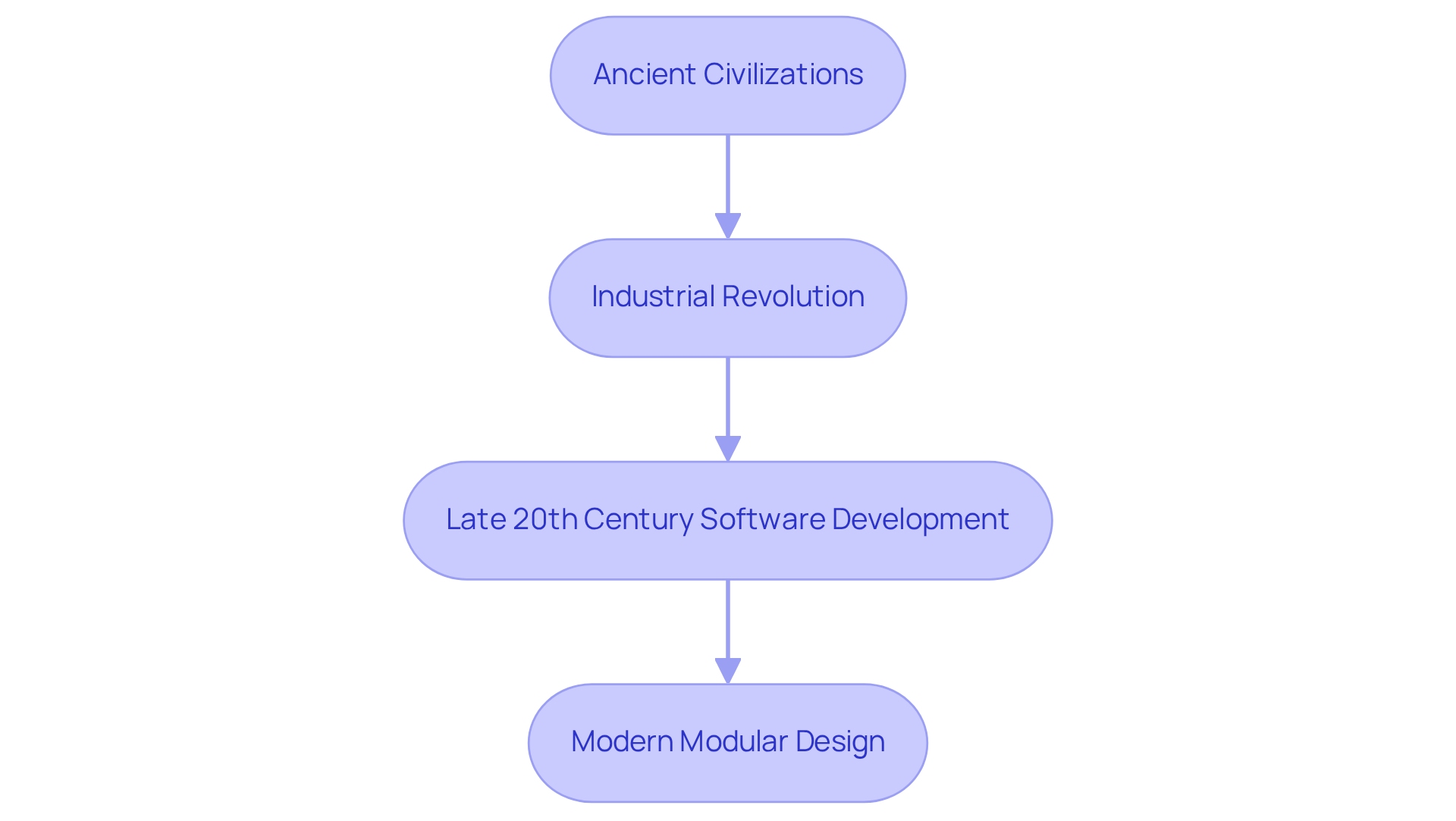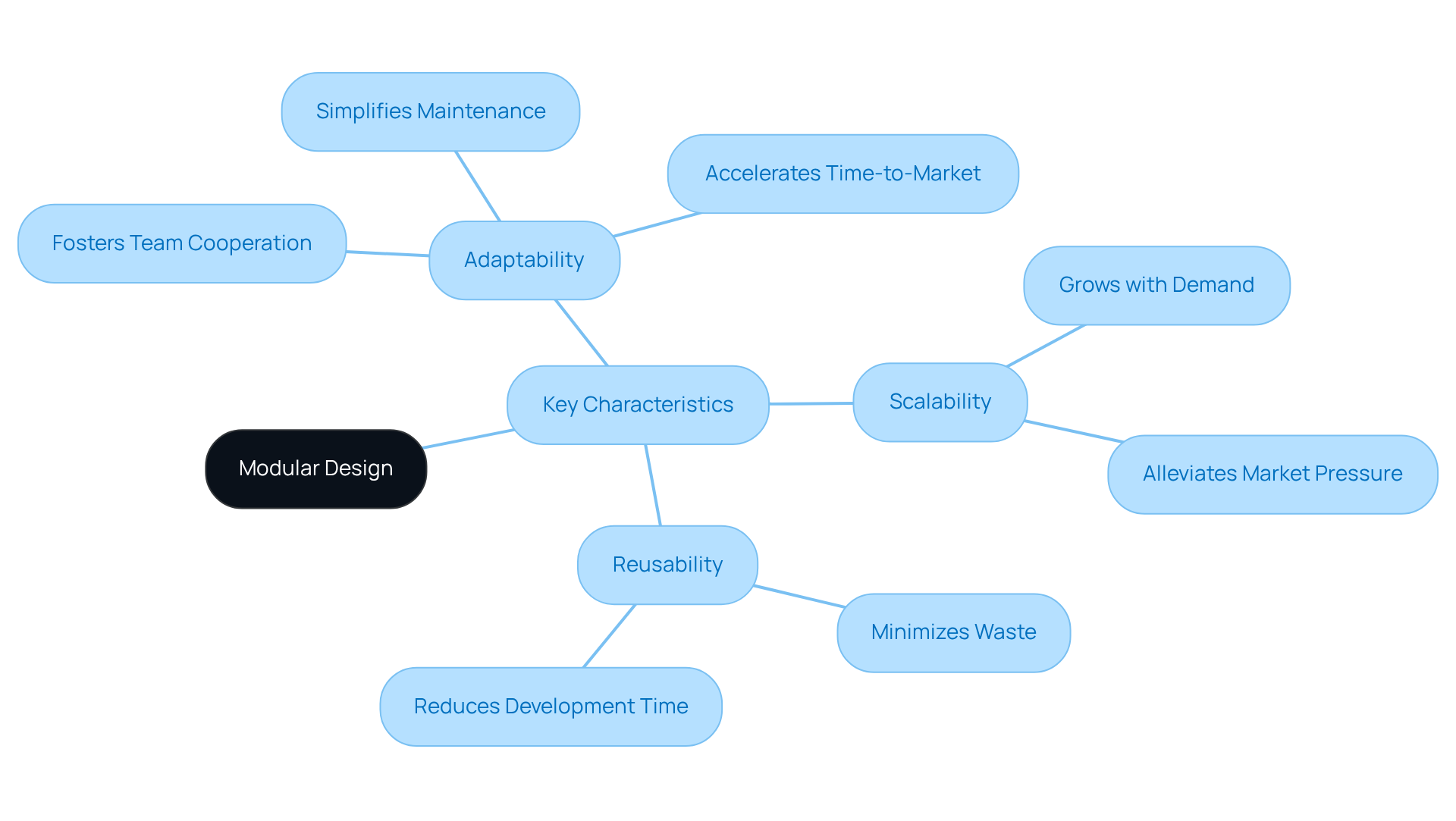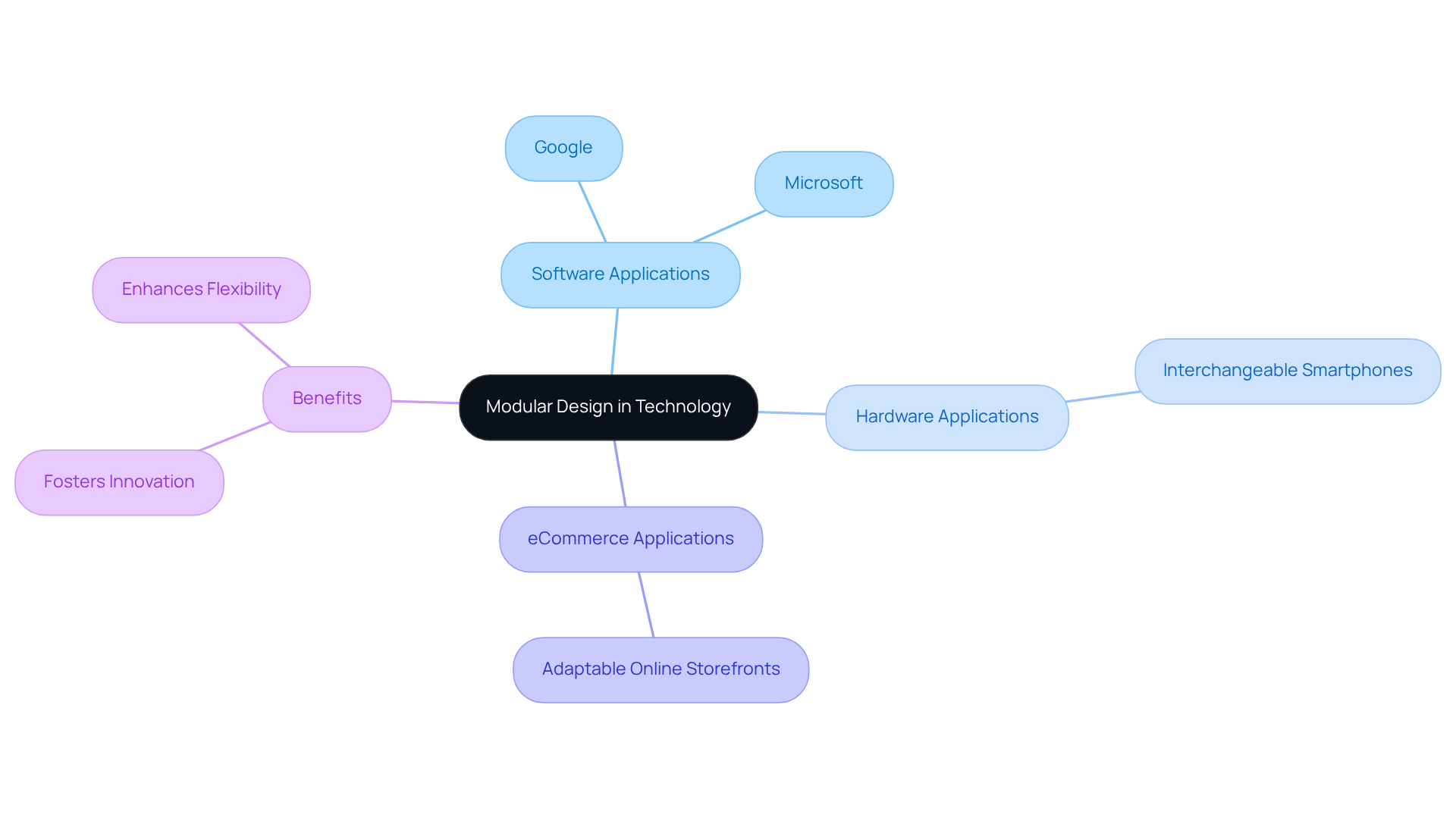Overview
In the fast-paced world of tech startups, many founders face the daunting challenge of adapting to rapidly changing markets. This can often feel overwhelming, as the pressure to innovate while keeping up with customer demands mounts. It’s a common struggle that can leave even the most passionate entrepreneurs feeling lost.
Modularity in design offers a compassionate solution to this problem. By breaking down systems into smaller, self-contained units known as modules, founders can create a flexible and adaptable framework that allows for independent or collaborative functionality. This approach not only simplifies processes but also fosters innovation and makes updates and maintenance more manageable.
Imagine the relief of having a design method that alleviates some of the burdens, enabling you to focus on what truly matters—growing your business. Embracing modularity could be the key to navigating the complexities of today’s market, providing the support and structure needed to thrive.
Introduction
In a world where technology evolves at breakneck speed, many founders may find themselves feeling overwhelmed by the complexity of building adaptable systems. This can be a daunting challenge, stirring feelings of frustration and uncertainty. However, modularity in design shines as a beacon of hope.
It offers a transformative approach that breaks down systems into manageable units, enhancing flexibility and fostering innovation. But how can embracing this modular structure not only simplify development but also empower teams to respond swiftly to market demands?
By exploring the essence of modularity, we uncover not just its key characteristics and historical evolution, but also its profound impact on nurturing a culture of continuous improvement and adaptability in the tech landscape. Together, let's navigate this journey towards a more agile and responsive future.
Define Modularity in Design
In the fast-paced world of tech startups, many founders grapple with the overwhelming complexity of building systems that can adapt to ever-changing market demands. This complexity can lead to frustration and a sense of being stuck, as traditional methods often fail to provide the flexibility needed to thrive.
The concept of modularity in design offers a nurturing solution to this pressing issue. By breaking down a system into smaller, self-contained units known as modules, each module can function independently or in harmony with others. This approach not only simplifies the creation process but also enhances customization and ease of maintenance. Imagine being able to adjust your offerings swiftly in response to new trends or technological advancements—this demonstrates the power of modularity in design.
This method is not just a technical strategy; it's a compassionate way to empower your team and your business. By embracing a modular structure, you can foster an environment where innovation flourishes, allowing you to respond to market needs with confidence.
As you navigate the challenges of your startup journey, remember that you are not alone. Many have walked this path and found success through modularity in design, transforming their visions into reality. At RNO1, we understand these struggles and are here to support you in creating a flexible and resilient foundation for your business.

Explore the Historical Context and Evolution of Modularity
The concept of flexibility has deep roots, tracing back to ancient civilizations that employed adaptable construction methods to create their buildings and structures. Yet, it was during the Industrial Revolution that this idea truly flourished. Manufacturers were faced with the challenge of streamlining production processes, and in their quest for efficiency, they introduced interchangeable parts. This innovation not only revolutionized manufacturing but also made mass production possible, significantly reducing costs. Fast forward to the late 20th century, and we see flexible construction principles embraced in software development. This shift led to the emergence of component-based programming languages and frameworks, which have transformed the way we approach technology. Today, as we navigate an ever-evolving landscape, modularity in design continues to adapt, fueled by technological advancements and the growing demand for customizable solutions across various sectors. It's a journey that reflects our need for adaptability in a world that is constantly changing, and it shows how we can meet those needs with compassion and innovation.

Identify Key Characteristics and Benefits of Modular Design
In the ever-evolving landscape of technology, many founders face the challenge of inflexible architecture. This rigidity can lead to frustration, as adapting to changing requirements becomes a daunting task. The implications of such inflexibility are significant: it can hinder collaboration, slow down development, and ultimately delay the launch of new offerings. However, there is hope. Embracing flexible architecture can transform this experience.
Key features of flexible architecture include adaptability, scalability, and reusability. Imagine a system where designers can seamlessly adjust modules to meet shifting demands, showcasing the concept of modularity in design. Scalability allows these systems to grow or shrink based on what is needed at any given time, alleviating the pressure that comes with fluctuating market conditions. Furthermore, reusability is a powerful ally; it minimizes waste and reduces development time, as existing modules can be repurposed for new projects.
The advantages of flexible structures are numerous. They foster cooperation among teams, simplify maintenance and enhancements, and accelerate time-to-market for new products. For instance, in application development, component-based structures empower programmers to focus on different elements simultaneously. This collaborative approach leads to quicker and more effective project fulfillment, allowing founders to bring their visions to life more efficiently.
By adopting flexible architecture that emphasizes modularity in design, you not only address the pain points of inflexibility but also create a nurturing environment where innovation can thrive. Together, we can navigate these challenges and build a more adaptable future.

Examine Real-World Applications of Modular Design in Technology
In the fast-paced world of technology, many startup founders face the challenge of inflexible designs that can stifle innovation and responsiveness. This can be frustrating, especially when updates and improvements require a complete overhaul of systems. Imagine the stress of needing to enhance your product but feeling trapped by your existing infrastructure.
Fortunately, there is a solution that involves modularity in design. Companies like Google and Microsoft have embraced flexible architectures in their software, allowing for simpler updates and feature enhancements without the need for a complete system revamp. This approach not only alleviates the pressure but also fosters a culture of continuous improvement.
In hardware, we see a similar trend with interchangeable smartphones, enabling users to upgrade specific components like cameras or batteries instead of replacing the entire device. This flexibility is empowering, as it allows users to tailor their technology to their individual needs.
In the realm of eCommerce, businesses are leveraging modular principles to create adaptable online storefronts. They can easily add or modify features based on customer feedback and evolving market trends, making it easier to connect with their audience.
These examples illustrate the versatility and effectiveness of modularity in design, which not only meets user needs but also nurtures innovation. As you navigate the complexities of your tech startup, consider how modularity in design can provide the support and flexibility you need to thrive in a competitive landscape.

Conclusion
Embracing modularity in design represents a transformative approach for tech startups grappling with the challenges of an ever-evolving market. Many founders find themselves overwhelmed by the rapid pace of change, feeling the pressure to innovate while managing limited resources. By breaking systems down into flexible, self-contained modules, businesses can simplify their development processes and enhance their ability to adapt to shifting demands. This method not only empowers teams to work collaboratively and efficiently but also nurtures a resilient foundation for success.
Throughout our journey, we’ve witnessed how key insights highlight the importance of modularity. Reflecting on its historical context, we can see how this concept has evolved from ancient construction methods to modern software development, demonstrating its enduring relevance. The characteristics of modular design—adaptability, scalability, and reusability—offer significant benefits, including improved collaboration, faster time-to-market, and reduced waste. Real-world applications from leading companies illustrate how modularity fosters a culture of continuous improvement and responsiveness to user needs, reminding us that innovation thrives in environments that embrace change.
Ultimately, adopting a modular design approach is not merely about technical efficiency; it’s about nurturing an innovative mindset that can flourish in a competitive landscape. As the technology sector continues to evolve, the ability to adapt and respond quickly to market changes will be crucial. By prioritizing modularity, businesses can empower themselves to not only meet current demands but also anticipate future opportunities, paving the way for sustained growth and success. We invite you to consider how embracing this approach can transform your startup, fostering a community of resilience and creativity that supports your journey forward.
Frequently Asked Questions
What is modularity in design?
Modularity in design refers to the practice of breaking down a system into smaller, self-contained units called modules, which can function independently or work together. This approach simplifies the creation process and enhances customization and maintenance.
How does modularity benefit tech startups?
Modularity benefits tech startups by providing flexibility to adapt to changing market demands, allowing for quick adjustments to offerings in response to new trends or technological advancements.
What are the advantages of using a modular structure?
The advantages of using a modular structure include simplified creation processes, improved customization, ease of maintenance, and the ability to foster innovation within teams.
How can modularity empower a team and business?
By embracing a modular design, teams can work in a more flexible environment that encourages creativity and innovation, enabling businesses to respond confidently to market needs.
Who can benefit from understanding modularity in design?
Founders and teams in tech startups, as well as anyone facing complexities in system building, can benefit from understanding and implementing modularity in design to create a more resilient and adaptable business foundation.




